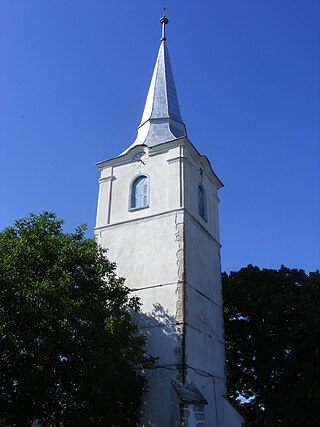
Hunedoara is a city in Hunedoara County, Transylvania, Romania. It is located in southwestern Transylvania near the Poiana Ruscă Mountains, and administers five villages: Boș (Bós), Groș (Grós), Hășdat, Peștișu Mare (Alpestes), and Răcăștia (Rákosd).

Galați is the capital city of Galați County in the historical region of Western Moldavia, in eastern Romania. Galați is a port town on the Danube River. and the sixth largest of all cities on the Danube river. According to the 2021 census it is the 8th most populous city in Romania. Galați is an economic centre based around the port of Galați, the naval shipyard, and the largest steel factory in Romania, Galați steel works.

Bihor County is a county (județ) in western Romania. With a total area of 7,544 km2 (2,913 sq mi), Bihor is Romania's 6th largest county geographically and the main county in the historical region of Crișana. Its capital city is Oradea.

Alba Iulia is a city that serves as the seat of Alba County in the west-central part of Romania. Located on the river Mureș in the historical region of Transylvania, it has a population of 63,536.

Drobeta-Turnu Severin, colloquially Severin, is a city in Mehedinți County, Oltenia, Romania, on the northern bank of the Danube, close to the Iron Gates. It is one of six Romanian county seats lying on the Danube river. "Drobeta" is the name of the ancient Dacian and Roman towns at the site, and the modern town of Turnu Severin received the additional name of Drobeta during Nicolae Ceaușescu's national-communist dictatorship as part of his myth-making efforts.

Curtea de Argeș is a city in Romania on the left bank of the river Argeș, where it flows through a valley of the Southern Carpathians, on the railway from Pitești to the Turnu Roșu Pass. It is part of Argeș County. The city also administers one village, Noapteș.

Baia Sprie is a town in Maramureș County, northern Romania. Baia Sprie is situated at a distance of 9 km (5.6 mi) from Baia Mare and belongs to the Baia Mare metropolitan area.

Daruvar is a spa town and municipality in Slavonia, northeastern Croatia, with a population of 8,567. The area including the surrounding villages has a population of 11,633 as of 2011.

Turda is a city in Cluj County, Transylvania, Romania. It is located in the southeastern part of the county, 34.2 km (21.3 mi) from the county seat, Cluj-Napoca, to which it is connected by the European route E81, and 6.7 km (4.2 mi) from nearby Câmpia Turzii.

Tokaj is a historical town in Borsod-Abaúj-Zemplén county, Northern Hungary, 54 kilometers from county capital Miskolc. It is the centre of the Tokaj-Hegyalja wine district where Tokaji wine is produced.

Szentes is a town in south-eastern Hungary, Csongrád county, near the Tisza river. The town is a cultural and educational center of the region. It is the third most populous town in Csongrad county after Szeged and Hódmezővásárhely.

Transdanubia is a traditional region of Hungary. It is also referred to as Hungarian Pannonia, or Pannonian Hungary.

Buziaș is a town in Timiș County, Romania. Thanks to its healing springs, it was once one of the most famous bathing places in Hungary and then in Romania; it has appeared in several international catalogs and has often been referred to as the "Pearl of Banat" or the "Bad Nauheim of Banat".

Târgu Lăpuș is a town in Maramureș County, northern Transylvania, Romania. It administers thirteen villages: Boiereni (Boérfalva), Borcut (Borkút), Cufoaia (Kohópatak), Dămăcușeni (Domokos), Dobricu Lăpușului (Láposdebrek), Dumbrava (Kisdebrecen), Fântânele, Groape (Groppa), Inău (Ünőmező), Răzoare (Macskamező), Rogoz (Rogoz), Rohia (Rohi), and Stoiceni (Sztojkafalva).

Shabla is a town and seaside resort in northeastern Bulgaria, administrative centre of the Shabla Municipality part of Dobrich Province. Shabla municipality includes the following villages: Bojanovo, Chernomortsi, Durankulak, Ezerets, Gorichane, Gorun, Granichar, Krapets, Prolez, Smin, Staevtsi, Tvarditsa, Tyulenovo, Vaklino, and Zahari Stoyanovo. As of December 2009, the town itself had a population of 3,586 inhabitants. It is situated on the Bulgarian Black Sea Coast in the vicinity of the salt-water Lake Shabla and Bulgaria's easternmost point, Cape Shabla.

Mărtiniș is a commune in Harghita County, Romania. It is composed of twelve villages: Aldea (Abásfalva), Bădeni (Bágy), Călugăreni (Homoródremete), Chinușu (Kénos), Comănești (Homoródkeményfalva), Ghipeș (Gyepes), Locodeni (Lókod), Mărtiniș, Orășeni (Városfalva), Petreni (Homoródszentpéter), Rareș (Recsenyéd), and Sânpaul (Homoródszentpál).

Merești is a commune in Harghita County, Romania. It lies in the Székely Land, an ethno-cultural region in eastern Transylvania. It is composed of a single village, Merești. Its elevation is 557 m (1,827 ft).

Sâncrăieni is a commune in Harghita County, Romania. Composed of a single village, Sâncrăieni, it lies in the Székely Land, an ethno-cultural region in eastern Transylvania. The former Romanian name was Ciuc-Sâncraiu.

Tamási is a town in Tolna County, Hungary, and is located just 30 kilometers east of Lake Balaton. Tamási is named after St. Thomas and has a population of approximately 9,200 people.

Törökbálint is a town in Pest county, Hungary. Törökbálint received town status on 1 July 2007.
























